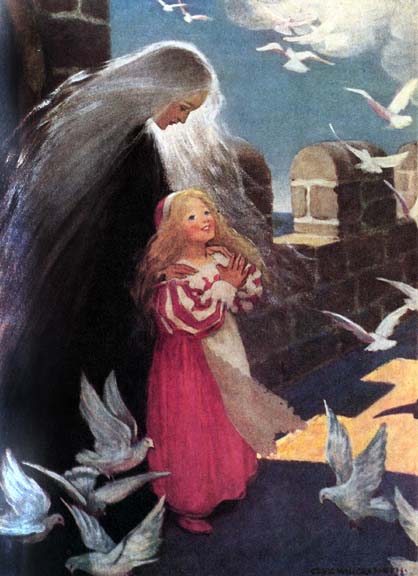This, the fourth and final installment of my series on Contemplative Prayer, contains a beautiful excerpt from George MacDonald’s fairy tale The Princess and the Goblin.
 Contemplative prayer is abandonment to God, trusting Him to accomplish in us whatever is necessary without our needing to understand what is going on. It is not rational, it is pure feeling. It is spiritual surgery that goes to the very root of our illness, the woundedness that inhibits us from feeling our deepest feelings.
Contemplative prayer is abandonment to God, trusting Him to accomplish in us whatever is necessary without our needing to understand what is going on. It is not rational, it is pure feeling. It is spiritual surgery that goes to the very root of our illness, the woundedness that inhibits us from feeling our deepest feelings.
According to Bessel van der Kolk, a psychiatrist who specializes in treating post-traumatic stress syndrome, the impact of trauma registers in the most primitive, non-rational areas of the brain, areas that have no access to cognition: the amygdala or alarm system, the insula which connects the brain with the body, Broca’s area which is the center of articulation, and so on. Accordingly, the treatments that are most successful for PTSD are not talk therapy, but non-rational, somatic techniques such as Rolfing, Yoga, EMDR, etc. Do you wonder why your talky, rational prayers are not touching your deepest needs? Try immersing yourself in pure feeling.
I hasten to add that a formal practice of contemplative prayer may not be for everyone. It may not be the right thing for you to pursue at this time. In some ways it’s like speaking in tongues—another form of prayer that bypasses the intellect. Not everyone has the gift of tongues. What’s really important, as always, is love. But love, it seems to me, requires a degree of rest: resting—just being—with the lover. “Be still, and know that I am God” (Ps 46:10). This much is for everyone. Rest is not something to achieve, but to receive. “Come to Me,” says Jesus, “and I will give you rest” (Mt 11:28).
 One year my wife made angel Christmas ornaments out of sheets of music paper covered in notes. She folded the sheets in such a way that each angel’s head contained only one musical symbol: a rest.
One year my wife made angel Christmas ornaments out of sheets of music paper covered in notes. She folded the sheets in such a way that each angel’s head contained only one musical symbol: a rest.
Recently I visited a dying friend who was very peaceful. I wondered what he might be thinking during his last days on earth, so I asked him. “I’m not thinking about anything,” he said with a smile. I replied, “That’s good. Thinking is overrated.” And he nodded.
This man had a wonderful mind. But in the end, this is what it all came down to: not thinking. I didn’t need to ask him what he was doing. He was just feeling. Feeling God. Resting obscurely in a foretaste of the kingdom of heaven to which he was so close.
Let’s close with some excerpts from George MacDonald’s lovely story The Princess and the Goblin. Princess Irene lives in a castle, and one moonlit night she discovers a stairway that ascends a tall turret into a tower room. There she finds an old woman at a spinning wheel, spinning something that looks like moonlight itself, so fine that Irene can hardly see it. She tells Irene it’s spider webs, the finest and strongest, brought by her pigeons from a certain forest over the great sea. On a later visit she hands the princess a shimmering ball of the stuff.
“There, Irene; this is my work for you!”
“How pretty it is! What am I to do with it, please?”
“That I will now explain to you,” answered the lady, [whereupon she took back the ball and placed it in a drawer in her cabinet. Then, placing a beautiful ring on Irene’s finger, she attached to it one end of the silvery thread.]
Looking at the ring, Irene said, “But I can’t see the thread, grandmother.”
“Feel—a little way from the ring—towards the cabinet,” said the lady.
“Oh! I do feel it! But I still can’t see it.”
“No. The thread is too fine for you to see it. You can only feel it.”
“But what use can I make of it, if the ball lies in your cabinet?”
“It would be no use to you at all,” answered the lady, “if it didn’t lie in my cabinet.”
[The lady instructs her that whenever she feels in danger, she should take off the ring and put it under her pillow, and then follow the thread wherever it goes.]
“Oh, how delightful!” exclaimed Irene. “It will lead me to you, grandmother, I know!”
“Yes. But remember, it may seem to you a very roundabout way indeed, and you must not doubt the thread. Of one thing you may be sure, that while you hold it, I hold it too.”
And of course the thread leads Irene into a dangerous, wonderful adventure.
[Illustration by Jessie Willcox Smith from the 1920 edition of The Princess and the Goblin.]
[End of Part 4, the final installment of “Feeling God.” Sign up here to receive weekly installments of this blog in your email box.]
